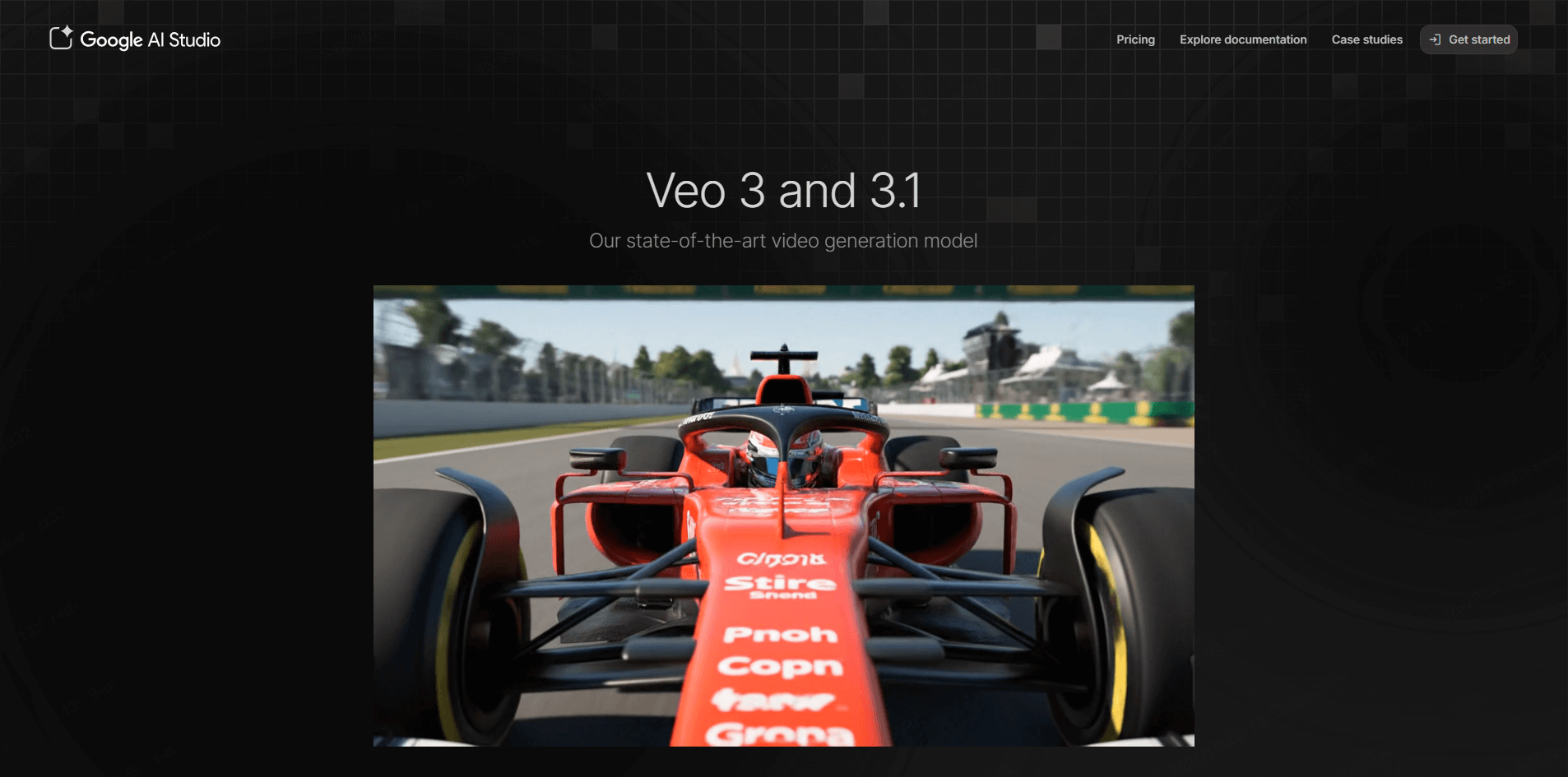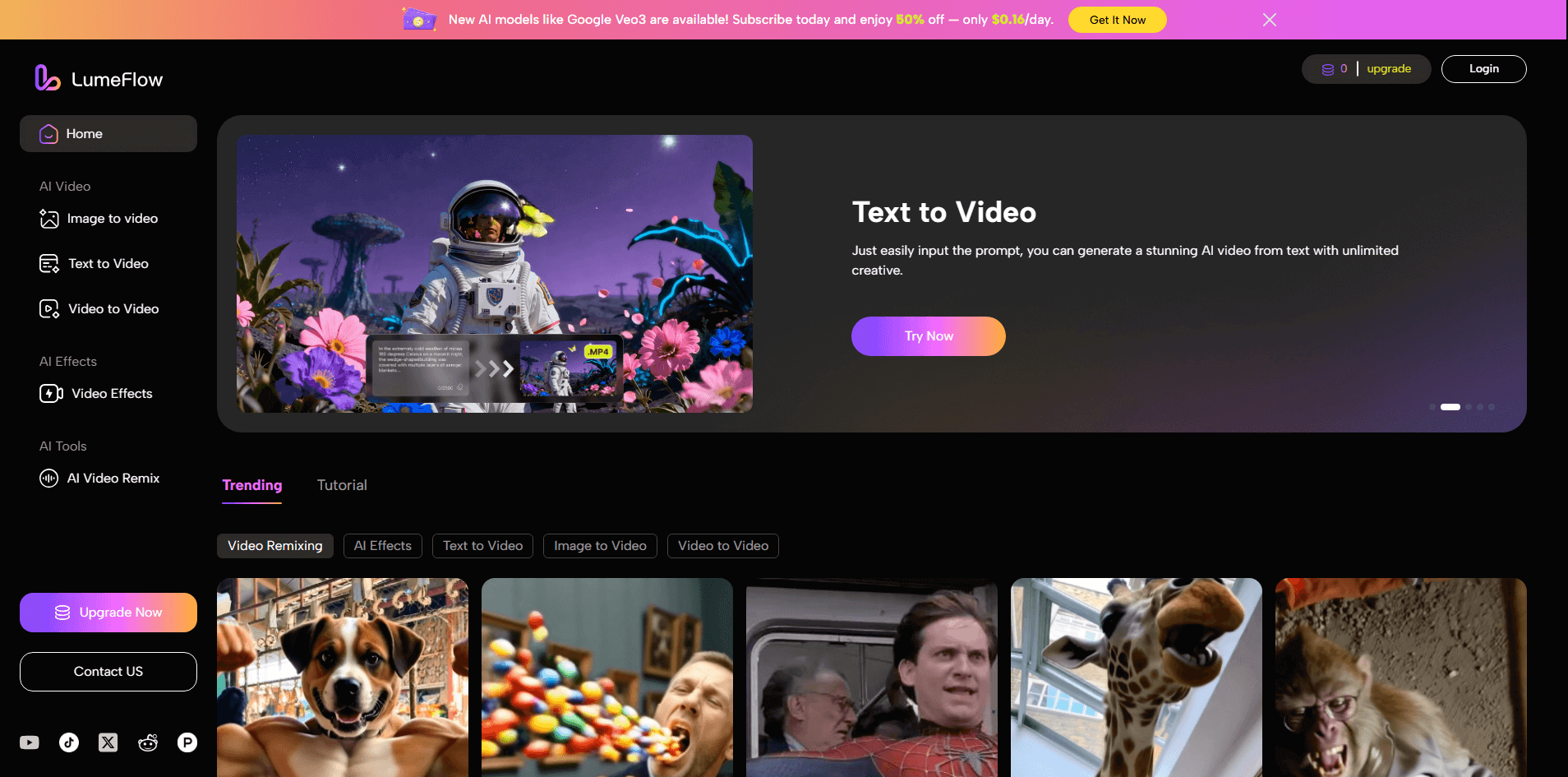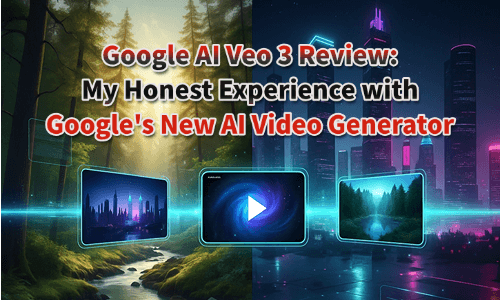I've been diving deep into AI video tools lately, exploring how different platforms handle realism, motion, and creative control. One tool that kept coming up in conversations is Google Veo 3 — it takes realism and motion control to a whole new level, much like what we cover in our Sora 2 review.
So I figured, why not? After all those tests, Veo 3 felt like the next must-try on my list. And honestly, it didn't disappoint — though it had a few surprises (and frustrations) along the way.
Veo 2 vs Veo 3 Comparison: What's New and What's Improved

Audio generation — finally!
Veo 3 can now generate audio directly within the clip — including voice, ambient sounds, and even light background music. That's something Veo 2 never did, and it completely changes how the videos feel. The first time I heard my generated scene come with synced dialogue, I actually grinned.
More cinematic visuals
The visuals in Veo 3 are noticeably more polished. Lighting is more realistic, movement feels smoother, and details like reflections or motion blur make scenes look more natural. When I compared clips side by side, Veo 2 looked flat — Veo 3 looked alive.
Smarter understanding of prompts
In Veo 2, it often ignored half of what I wrote. Veo 3 gets it right more often. It actually tries to interpret camera angles, moods, and lighting in a way that feels close to what I imagined.
Still short clips, though
Most videos are 8 seconds long — not enough for storytelling yet, but good for short reels or creative snippets.
So overall, if you've been wondering "veo 2 vs 3 — is it worth it?" I'd say yes, the jump is meaningful. But it's not magic — yet.
TL;DR
After spending a week testing Google Veo 3, here's my honest summary:
Pros
- Beautiful, cinematic visuals
- Realistic lighting and smoother motion
- Audio + dialogue generation (huge upgrade)
- Better understanding of complex prompts
Cons
- Expensive and limited access
- Some bugs with audio and subtitle sync
- Still short clips and occasional inconsistencies
If you're looking for a quick Veo 3 review verdict: it's one of the most impressive AI video tools out there, but not the easiest or cheapest to use.
My Veo 3 Testing Process: Video, Audio, Lip-Sync, and More
I didn't want this to be just another "I watched Google's demo" review. I actually generated multiple clips using Flow and Veo 3, testing everything from dialogue scenes to anime-style sequences.
How I tested it
I ran Veo 3 through a few simple and complex prompts, testing:
- 🎥 Video realism and lighting
- 🔊 Audio generation and lip-sync
- 💬 Subtitle quality
- 🎞 Consistency when generating multiple scenes in Flow
I also ran into that common issue — "trouble creating another Veo 3 after the first in Flow" — where my second clip would take forever to render or just fail. It's a bit of a patience game.
Prompts & real results
Here are a few of my test cases:
Prompt 1
"A travel vlogger talking to the camera in a Tokyo street market, ambient crowd noise, natural speech with English subtitles synced to dialogue."
The scene felt incredibly lifelike — the warm Tokyo lighting reflected off nearby shop signs, and the busy market crowd looked naturally in motion. The male vlogger's lip movements aligned almost perfectly with his speech, and his tone matched the subtle background chatter. But around the six-second mark, he stopped mid-sentence and held the same facial expression for the rest of the clip. It slightly broke the immersion, though the overall realism was still quite impressive for such a short AI-generated video.
Prompt 2
"A reporter interviewing a person on a busy New York street, natural dialogue, city sounds."
This one looked impressively real — the city ambience was spot-on, and the reporter's mic even had that subtle pop you'd expect in a real street interview. One passerby glanced at the camera and quickly turned away, which added a nice touch of authenticity. The dialogue felt smooth and believable, perfectly matching the scene. The only odd detail was a flag in the background with an incomplete pattern, and maybe a few too many taxis crowding the street. But still, for just a single-sentence prompt, the level of realism was genuinely impressive.
Prompt 3
"Two anime characters facing off on a rooftop at sunset, dramatic music, sword clash."
The clip clearly aimed for an anime-inspired look, and the lighting and character design were quite well done. But the fight sequence didn't play out smoothly — there was an odd pause before the action started, and the two swords looked inconsistent, with one glowing vividly while the other showed no light effect at all. The sword sound was timed almost perfectly, but the swings themselves felt a bit stiff and slow. It's clear Veo 3 is trying to capture that anime energy, but it still needs some polish to feel truly dynamic.
Prompt 4
"Product demo video for a sports camera, narrator voice-over explaining specs."
This one actually looked impressively cohesive — smooth pacing, clean cuts, and a well-synced voice-over that gave it a proper commercial feel. Still, a few details stood out on closer look: the hands introducing the product and the male narration didn't quite match the final shot, where a woman is suddenly holding the camera. The device screen also behaved a bit strangely, showing a menu triggered by a button that doesn't seem to exist, and the display didn't align with what was happening in the scene. These minor mismatches remind you it's still AI, but for a generated product demo, Veo 3 handled the overall structure surprisingly well.
What stood out
Veo 3 feels alive when it works. Seeing it create full cinematic motion from just a line of text is honestly mind-blowing. But it's unpredictable — some clips nailed the emotion; others went weirdly off-script.
And yes, sometimes it's slow. The "slow Veo3" complaint you see online is real — rendering isn't instant.
How Google Flow Works Alongside Veo 3
Flow is Google's companion tool for Veo 3, and it's honestly where things start to get interesting. Think of it as your creative dashboard — a space where you can organize scenes, prompts, and assets.
What Flow actually does
Flow lets you:
- 🔗 Chain Veo 3 clips into longer sequences
- 🎨 Add or remix your own assets (images, short videos)
- 📦 Manage storyboards and adjust pacing
So instead of generating one 8-second clip at a time, Flow helps you connect them. You can even reuse characters or camera styles across scenes.
Flow vs Veo 3
A lot of people confuse Flow with Veo 3, but here's the difference:
- 💡 Veo 3 = the video generation model.
- 💡 Flow = the workspace that helps you build stories with Veo 3.
Together, they form a pretty powerful pipeline — but Flow's still new, so expect a few hiccups.
Google Veo 3 Performance: Impressive, But Not Always Consistent
Here's where I have to be honest — Veo 3 blew me away sometimes, but frustrated me other times.
Prompt unpredictability
Sometimes Veo 3 ignores parts of your prompt. When I tried a more complex idea — "An anime-style reimagining of La La Land with a singing couple under neon lights, smooth camera motion, background jazz, and auto-generated subtitles matching each lyric" — Veo 3 produced something that looked smooth and sounded lovely.
The duet felt natural, and the transitions were handled impressively well. However, it completely missed part of the brief: instead of a dreamy neon-lit stage, the background turned into what looked like a busy shopping street, with static bystanders frozen in place. It didn't quite capture the romantic, cinematic feel of La La Land. This shows that Veo 3 still struggles to fully interpret layered or stylistic prompts — to get exactly what you want, you'll probably need to add more detailed, scene-specific cues. It's better than Veo 2, but not fully reliable yet.
Subtitle glitches
Some reviewers mentioned that Veo 3 tends to mess up subtitles, so I tried to see it for myself. In several prompts where I specifically asked for synced captions, Veo 3 simply… didn't generate any. No subtitles, no glitches — nothing. I'm not sure if that's better or worse, honestly. It avoided the weird scrambled text others reported, but it also ignored the instruction completely. Looks like the subtitle function is still hit or miss for now.
Consistency issues
Some Veo 3 videos end up with odd or unrealistic scenes.
For example, the "reporter and interviewee" prompt 2 I mentioned earlier actually produced another version — this time, they were standing right in the middle of the street. Not exactly the safest setup for an interview.
In another clip, the ending frame turned blurry, as if the render glitched out midway.

It doesn't ruin the whole experience, but it does show that Veo 3 still struggles with consistency from scene to scene.
So yes, veo 3 premium gives you better results, but it's not always consistent enough for longer storytelling.
Veo 3 Access and Pricing Limitations
Now let's talk cost — because it's not cheap.
The Veo 3 + Flow combo comes as part of Google AI Ultra, which runs around $249/month in the US. Some creators also pay around $0.75 per second for video + audio generation through the API.
So when people ask "does Veo 3 cost money?" — yes, it definitely does. It's aimed more at professionals and studios than hobbyists.
Veo 3 Alternatives: Try LumeFlow AI
If you're curious about AI video generation but don't want to drop hundreds a month, there's another option I've been enjoying — LumeFlow AI.

LumeFlow AI offers text-to-video and video remix features similar to Flow, but much more affordable — plus a free tier for testing. You can generate short clips, experiment with prompts, and even remix existing footage. It also supports Google Veo 3 models for high-quality video generation, giving you access to the latest realism and motion upgrades without the premium price tag. And if you need more power, its lowest paid plan starts at just $4.99 per month — still far more budget-friendly than most competitors.
In fact, for casual creators or small teams, LumeFlow AI feels like the practical middle ground. It's beginner-friendly, cheaper, and lets you explore similar creative possibilities without the Google paywall. And if you want to try other AI tools, it also offers access to popular models like Sora 2, Pixverse AI, and Kling AI — all in one place.
So while I love what Veo 3 can do, LumeFlow AI is where I'd start if you're just exploring this space.
Final Thoughts
Veo 3 is one of the most advanced AI video models I've ever used. When it hits, it really hits. The visuals, motion, and sound integration are next-level.
But it's not perfect. It's expensive, sometimes buggy, and requires patience to get consistent results.
If you're serious about AI filmmaking, Veo 3 + Flow is worth exploring.
If you just want to experiment or learn, start with LumeFlow AI — it's way more accessible and still surprisingly powerful.
Either way, the future of AI video creation looks insanely exciting — and Veo 3 is a big part of why.









